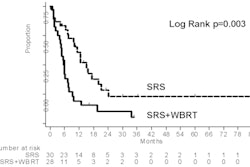Children with acute lymphoblastic leukemia (ALL) can be successfully treated without exposure to cranial radiation, investigators at St. Jude Children's Research Hospital report in the June 25 issue of the New England Journal of Medicine.
Treatment to prevent recurrence of leukemia in the central nervous system can be achieved with intensified risk-adjusted intrathecal and systemic chemotherapy, according to the study (NEJM, June 2009, Vol. 360:276, pp. 30-41).
This finding brings the use of prophylactic cranial irradiation to treat this disease full circle. In the mid-1960s, Memphis, TN-based St. Jude's pioneered the use of cranial irradiation as a treatment strategy that advanced the cure of childhood ALL from 4% to a 50% rate. However, although effective, cranial radiation produces side effects that include second cancers, stunted growth, hormone imbalances, and cognitive defects.
In the new study, children newly diagnosed with ALL from June 2000 through October 2007 were enrolled in a trial conducted at St. Jude Children's Research Hospital (with 411 patients) and Cook Children's Medical Center (with 90 patients) in Fort Worth, TX. Its primary objective was to determine whether prophylactic cranial irradiation could be safely omitted, especially for those patients who would have received the treatment after one year of complete remission. The second objective was to estimate the overall event-free survival, according to principal investigator Dr. Ching-Hon Pui, St, Jude's chairman of the department of oncology, and colleagues.
Of the 498 patients, 98.8% entered complete remission. Thirty-three patients relapsed and 12 patients died. The risk of relapse was determined by the measurement of residual leukemia cells, or minimal residual disease, present after remission induction treatment. This measurement was used to modify therapy based on the level of the disease detected. Personalized therapies based on the molecular genetics of ALL, the pharmacogenetic traits of patients, and pharmacodynamic principles were developed for each patient.
Seventy-one patients met previous criteria for receiving prophylactic central nervous system (CNS) irradiation, and their disease-free and overall survival were compared against a historic control group of 56 previously treated patients with similar disease and demographic characteristics who had received radiation. The five-year rate of continuous complete remission after one year of continuous therapy was 90.8% for the clinical trial group and 73.0% for the control group.
Without prophylactic cranial irradiation, the researchers were able to identify risk factors for CNS relapse. Eleven patients who developed an isolated CNS relapse received one course of therapeutic radiation and have remained in second remission. In a new ongoing clinical trial, patients at high risk for CNS relapse are receiving intensified intrathecal treatment to avoid any use of cranial irradiation.
Related Reading
Cranial radiotherapy tied to elevated adiposity, metabolic risk in ALL survivors, November 20, 2007
High BMI tied to osteonecrosis in childhood leukemia, May 7, 2007
Lifelong follow-up for second cancers seems needed for childhood ALL survivors, March 22, 2007
Brain imaging reflects neurotoxicity in childhood cancer survivors, March 6, 2006
Skipping radiotherapy may benefit childhood leukemia survivors in the long run, August 21, 2003
Copyright © 2009 AuntMinnie.com



















